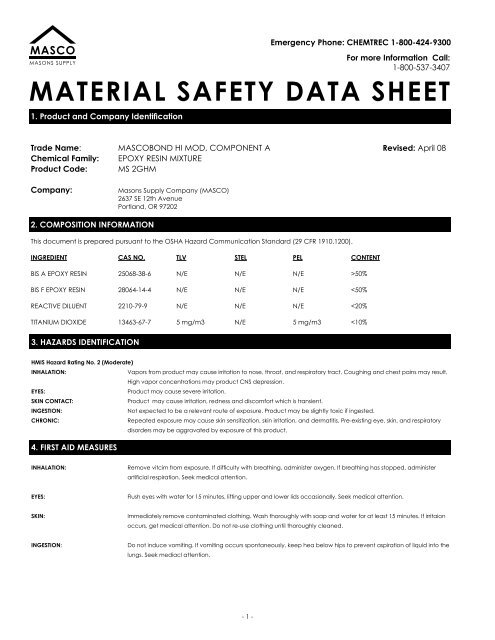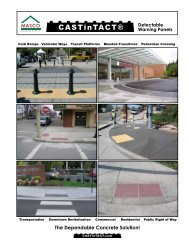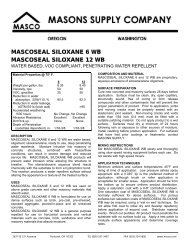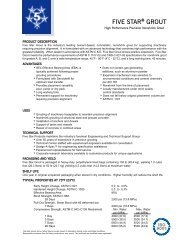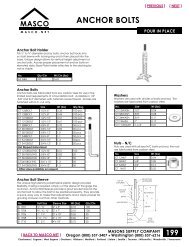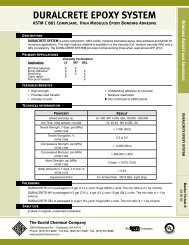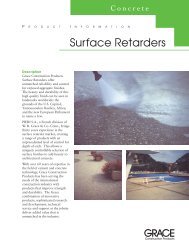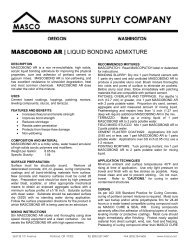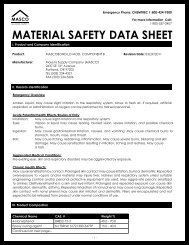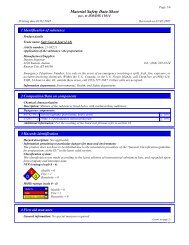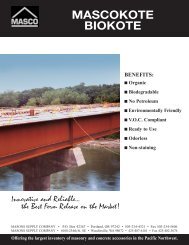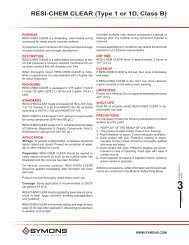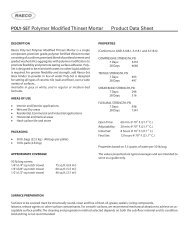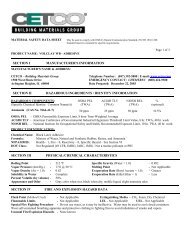MASCOBOND HI MOD, COMPONENT A - MSDS - masco.net
MASCOBOND HI MOD, COMPONENT A - MSDS - masco.net
MASCOBOND HI MOD, COMPONENT A - MSDS - masco.net
Create successful ePaper yourself
Turn your PDF publications into a flip-book with our unique Google optimized e-Paper software.
MATERIAL SAFETY DATA SHEET<br />
1. Product and Company Identification<br />
Emergency Phone: CHEMTREC 1-800-424-9300<br />
For more Information Call:<br />
1-800-537-3407<br />
Trade Name:<br />
Chemical Family:<br />
Product Code:<br />
Company:<br />
<strong>MASCOBOND</strong> <strong>HI</strong> <strong>MOD</strong>, <strong>COMPONENT</strong> A<br />
EPOXY RESIN MIXTURE<br />
MS 2GHM<br />
Masons Supply Company (MASCO)<br />
2637 SE 12th Avenue<br />
Portland, OR 97202<br />
Revised: April 08<br />
2. COMPOSITION INFORMATION<br />
This document is prepared pursuant to the OSHA Hazard Communication Standard (29 CFR 1910.1200).<br />
INGREDIENT CAS NO. TLV STEL PEL CONTENT<br />
BIS A EPOXY RESIN 25068-38-6 N/E N/E N/E >50%<br />
BIS F EPOXY RESIN 28064-14-4 N/E N/E N/E
<strong>MASCOBOND</strong> <strong>HI</strong> <strong>MOD</strong>, <strong>COMPONENT</strong> A | msds<br />
5. FIRE FIGHTING METHODS<br />
HMIS HAZARD RATING NO. 1 (Slight)<br />
Flash Point: >200 o F<br />
METHOD: SETAFLASH<br />
AUTO-IGNITION TEMP.: Not available<br />
LIMITS OF FLAMMABILITY: LEL: Not available UEL: Not Available<br />
EXTINGUIS<strong>HI</strong>NG MEDIA: Use water fog, dry chemical or CO 2<br />
.<br />
SPECIAL FIRE FIGHTING PROCEDURES AND PRECAUTIONS: Do not enter confined fire space without full bunker gear (helmet with face shield, bunker coats,<br />
gloves and rubber boots), including a positive pressure NIOSH approved self-contained breathing apparatus. Cool fire exposed containers with water.<br />
UNUSUAL FIRE AND EXPLOSION HAZARDS: Containers exposed to intense heat from fires should be cooled with water to prevent vapor pressure buildup which<br />
could result in container rupture.<br />
6. ACCIDENTAL RELEASE MEASURES<br />
ACTION TO TAKE FOR SPILLS / LEAKS: Clean up personnel must be equipped with self-contained breathing apparatus, rubber gloves and protective clothing.<br />
Dike and contain spill. Soak up residue with an absorbent such as clay, sand or other suitable material. Dispose of the absorbent material in accordance<br />
with federal, state and local regulations. Residual resin may be removed with hot soapy water.<br />
WASTE DISPOSAL METHOD: Dispose in compliance with federal, state and local regulations.<br />
7. HANDLING AND STORAGE<br />
HANDLING: Keep away from open flames and high temperatures.<br />
STORAGE: Store in a well ventilated area.<br />
8. EXPOSURE CONTROLS/PERSONAL PROTECTION<br />
RESPIRATORY PROTECTION: Avoid prolonged or repeated breathing of vapors. Use a NIOSH approved respirator to prevent overexposure. In accord with 29<br />
CFR 1910.134, use a full face, air supplying respirator or an air-purifying respirator for organic vapors.<br />
PROTECTIVE CLOT<strong>HI</strong>NG: Do not get on skin or clothing. Wear chemical resistant protective clothing, gloves, and boots. Wear chemical goggles to prevent<br />
contact with eyes.<br />
ADDITIONAL PROTECTIVE MEASURES: Use explosion proof ventilation to control vapors or mist concentrations. Eye wash fountains and safety showers should<br />
be available for emergency use.<br />
9. PHYSICAL AND CHEMICAL PROPERTIES<br />
Water/Oil Distribution Coefficient: N/AV Odor: Slight<br />
Boiling Point ( 0 C): N/AV Solubility in Water: Negligible<br />
Percent Volatile: 0.1% Specific Gravity: 1.13<br />
Freezing Point ( 0 C): N/AV pH: N/AV<br />
Vapor Pressure mmHg @ 20 0 C: Air<br />
Odor Threshold:<br />
N/AV<br />
Appearance:<br />
Gray Liquid<br />
N/AV = Not Available<br />
ca. = Approximate<br />
10. STABILITY AND REACTIVITY<br />
HMIS Hazard Rating No. 0<br />
STABILITY: Stable, Hazardous polymerization will not occur.<br />
CONDITIONS AND MATERIALS TO AVOID: Avoid heat, flame and contact with strong oxidizing agents. Contamination with strong acids, bases, amines, and<br />
mercaptans may cause an exothermic polymerization. Do not store or handle in aluminum equipment at temperatures above 120 0 F.<br />
HAZARDOUS DECOMPOSITION PRODUCTS: Carbon monoxide, aldehydes and acids may be formed during combustion.<br />
- 2 -
<strong>MASCOBOND</strong> <strong>HI</strong> <strong>MOD</strong>, <strong>COMPONENT</strong> A | msds<br />
11. TOXICITY INFORMATION<br />
HMIS Hazard Rating No. 2 (Moderate)<br />
PRIMARY ROUTE OF ENTERY: Inhalation, Dermal, Eyes<br />
EFFECTS OF OVEREXPOSURE<br />
INHALATION:<br />
May cause irritation on the respiratory tract.<br />
LC(50) INHAL.<br />
EYES:<br />
SKIN CONTACT:<br />
SKIN ABSORPTION:<br />
INGESTION:<br />
LD(50) ORAL:<br />
CHRONIC:<br />
N/AV<br />
May be irritating to the skin. In some individuals it may cause sensitization.<br />
May be irritating to the skin. In some individuals it may cause sensitization.<br />
No information available.<br />
Not expected to be a relevant route of entry. May be slightly toxic if ingested.<br />
CAS. NO.<br />
25068-38-6: 11.4 g/kg (rat)<br />
2461-15-6: 7.8 g/kg (rat)<br />
Product does not contain chemicals considered to be carcinogenic by NTP, IARC, or OSHA.<br />
This product contains residual (


